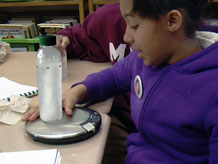What happens to weight and volume when water freezes?
2. Collect data

Distribute the materials.
Do students notice condensation on the outside of the frozen water bottles? Remind them that the condensation is coming from water vapor in the classroom air, and that condensation is the reverse of evaporation. Water vapor in the air is cooling against the cold surface and condensing on it. They'll need to dry the condensation from the bottles before they weigh them, so they'll get an accurate weight for just the bottle and the ice inside of it. Students record their findings in the data table on the page [What happens to weight and volume when water freezes and ice melts?] in their Science Notebooks.
- Dry condensation from the container.
- Measure and record the weight.
- Observe and record the volume by checking the level of the ice. Did it stay the same, increase, or decrease?
- Complete [What happens to weight and volume when water freezes?] reflections in the Science Notebooks.



